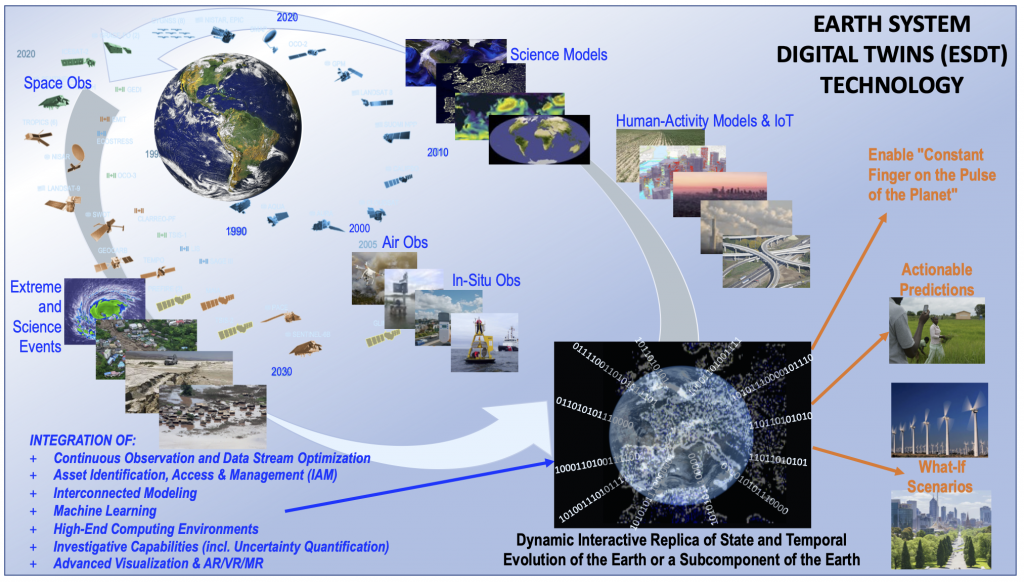Advanced Modeling Technology
Enabling paradigm shifts in Earth Science modeling, prediction, simulation, and utilization.
Program Manager – Laura Rogers
Advanced Information Systems Technology (AIST) Program
In 2024, ESTO added the Advanced Modeling Technology (AMT) program to bring renewed focus to modeling efforts, previously a subset domain within the Advanced Information Systems Technology (AIST) program. AMT aims to expand current definitions of modeling and leverage state-of-the-art computer and information science for innovating advanced modeling techniques as well as new technologies and frameworks that will be essential in the development of Earth System Digital Twins.
Earth System Digital Twins
AMT defines an Earth System Digital Twin (ESDT) as an interactive and integrated multidomain, multiscale, digital replica of the state and temporal evolution of Earth systems. It dynamically integrates: relevant Earth system models and simulations; other relevant models (e.g., related to the world’s infrastructure); continuous and timely (including near real time and direct readout) observations (e.g., space, air, ground, over/underwater, Internet of Things (IoT), socioeconomic); long-time records; as well as analytics and artificial intelligence tools. Effective ESDTs enable users to run hypothetical scenarios to improve the understanding, prediction of and mitigation/response to Earth system processes, natural phenomena and human activities as well as their many interactions.

An ESDT is a type of integrated information system that, for example, enables continuous assessment of impact from naturally occurring and/or human activities on physical and natural environments.
ESDT strategic goals are to:
- Develop information system frameworks to provide continuous and accurate representations of systems as they change over time;
- Mirror various Earth science systems and utilize the combination of Data Analytics, Artificial Intelligence, Digital Thread , and state-of-the-art models to help predict the Earth’s response to various phenomena;
- Provide the tools to conduct “what if” investigations that can result in actionable predictions.
The ESDT thrust will spur capabilities toward the development of future digital twins of the Earth or of subcomponents of the Earth, as well as toward the development of an overarching framework that will continuously evolve and connect the various components developed by Research and Analysis, Applied Sciences, Data Systems, and Computational Capabilities from other Earth Science Programs. From an AMT point of view, ESDT capabilities will integrate Earth observations analysis and understanding capabilities provided by Analytic Collaborative Framework (ACF) systems and on-demand and timely IoT and IoS data using Novel Observing System (NOS) capabilities, while taking advantage of advanced Machine Learning, Big Data Analytics, and powerful computational and visualization capabilities.
For more background information about Digital Twins and related technologies, please visit our ESDT webpage or download this list of references (PDF / 133 KB).
Events & Reports
AMT and AIST programs host workshops, conferences, and project reviews to educate the science community about breakthroughs in the world of information systems.
Events and ReportsAMT and AIST Project Highlights
Novel Algorithms Merge Ground- and Space-based Data to Forecast Air Pollution Events
A NASA-sponsored research team is developing new machine-learning software that uses data from satellites and ground-based sensors to forecast air pollution events in Los Angeles.
Novel software testbed helps prepare sensors for future cooperative networks
A collaborative team of researchers from numerous organizations demonstrated a novel software platform that will help networks of dispersed sensors share information with each other more efficiently.
NASA Agricultural Digital Twin will help farmers improve crop yield forecasts
A team of researchers supported by ESTO is developing an agriculture information system that will provide farmers with better agricultural productivity forecasts.
Solicitations
AMT uses the NASA Research Announcement as its investment vehicle. Links to the full solicitations and awards are listed below.
In addition to projects transferred to AMT from AIST, 13 AMT projects were selected under the 2023 solicitation for the Advanced Information Systems Technology (AIST) Program (element A.58 of the ROSES-23 omnibus announcement).
—
AMT Solicitations
| Solicitation | Link To Solicitation | Link To Award |
|---|---|---|
| AIST ROSES 2023 (includes AMT assignments) | Solicitation Closed | Updates Pending |